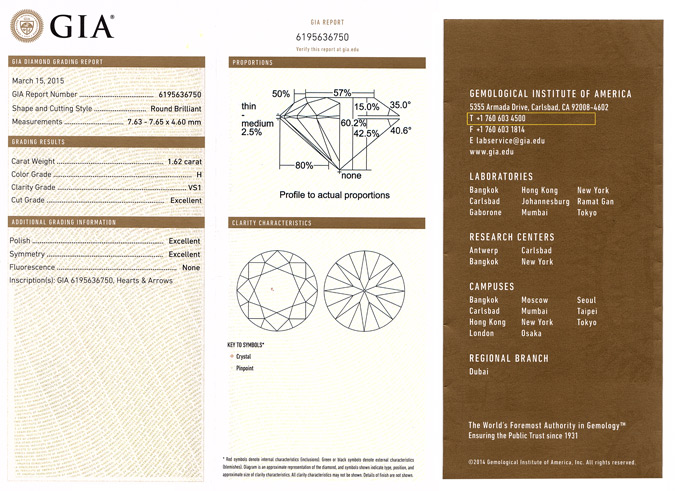
In my opinion, the Gemological Institute of America (G.I.A.) diamond grading reports are the most accurate and reliable that are readily available. Occasionally, I will use diamond grading reports issued by the American Gem Society. I do not use diamond grading reports from other gemological laboratories.
Only about 2%-3% of G.I.A. certified round diamonds with an Excellent cut grade meet my criteria (based on round diamond samples taken from www.Rapnet.com from 2014 - 2017 ). As noted in a study conducted by Gemworld International and published in the July/August 2014 edition of the GemGuide (a wholesale pricing guide primarily for jewelry appraisers), 67.6% or 2/3 of all round diamonds in a sample of 117,679 stones, received an Excellent cut grade from G.I.A. (Excellent is G.I.A.'s highest rating for cut). The November/December 2014 edition of the GemGuide states "approximately 75% of the round diamonds that go through the GIA lab, receive an Excellent cut grade." The vast majority of G.I.A. certified diamonds with an Excellent cut grade do not meet Dimonz' criteria, which represent less than 3% of the round diamond market.
Also, it is important to note that within the past few years, G.I.A. has established diamond grading laboratories in Bangkok, Gaborone, Mumbai, Ramat Gan and Tokyo. I have not personally seen diamonds and accompanying Reports/Dossiers from some of these these newer laboratories and do not have first-hand knowledge as to whether or not they are as consistent and reliable as the older diamond grading laboratories such as the Carlsbad (formerly in Santa Monica), Johannesburg, and New York laboratories. The location of the diamond grading laboratory that issued the Report/Dossier is identified at the top of the last page. I have heard bad reviews from reliable trade sources of the diamond grading at one of the GIA laboratories mentioned.
G.I.A. Reports/Dossiers for Round Brilliant Cut Diamonds-- Most of the information you need to evaluate the quality of a round brilliant diamond is contained in a G.I.A. Report/Dossier. Please also read the segment of this website on Cut under the "Four C's".
G.I.A. Reports/Dossiers for Fancy Shape Diamonds In my opinion, G.I.A. Reports/Dossiers for fancy shape diamonds (e.g. cushion cut, princess cut, emerald cut, radiant cut, pear shape, oval, marquise, heart shape, et al) do not contain sufficient
information to let you know whether or not the diamond you are
considering is of good quality and a good buy from the standpoint of cut. While the color, clarity and carat
weight of a fancy shape diamond are described, the diamond grading report doesn't
tell you enough about the cut.
For example, marquises, pears,
radiants and ovals frequently have pronounced dark spots in
the center in the shape of a bow-tie and/or may have an undesirable
shape.
--Princess cut diamonds tend to be cut too deep to save weight from the rough (i.e., the total depth percentage is over 73% of the width of the stone) and they have dark, extinguished areas in the center of the stone (sometimes called the X effect because the dark spot in some deep stones frequently looks like an X); they tend to have thin crowns (under 10% of the width of the stone) which negatively affects the play of light;
and they look smaller than their weight
would indicate when mounted. In other words
-- Pear shapes are often shaped more like shields than the ideal "teardrop" shape (this is known as having "high shoulders and
a flat head"). Emerald-cut diamonds tend to be
cut too squarish, too deep, with excessively large tables or with bulged pavilions in order to save weight from the rough,
creating a dark, smallish looking diamond with an unappealing
shape. Many oval and marquise shaped diamonds are cut too
wide or fat to retain weight from the rough and have "bulged" or "flat"
wings" (i.e., the four arcs that form the outline of the stone
are flattened rather than rounded). G.I.A. reports and dossiers for fancy shaped diamonds do not contain the crown height percentage (ie., the height of the crown of the diamond expressed as a percentage of the width of the stone) which is crucial in determining the optical efficiency of the stone. Also, many fancy shaped diamonds fall outside of the preferred length-to-width ratio necessary to optimize the visual appeal of the stone. These are just some of the problems you encounter
when buying a fancy shape. In my opinion, very few fancy shape diamonds are even reasonably well cut.
The
bottom line is that you cannot buy a fancy shape diamond based on the information given in the G.I.A. report. A quote from Rapaport Diamond Report (the diamond trade Bible, regarding wholesale diamond prices):
"Fancy shape diamonds are more complex than round diamonds and much harder to valuate. The quality of cut, proportions and overall shape of the fancy shape diamond all have great impact on price and liquidity. Poorly cut stones may trade at substantial discounts, while well shaped fine cut stones may trade at a premium. There is also a higher degree of availability difficulties in the fancy market and you may pay significantly higher prices for a select fine stone..... It is not advisable to trade diamonds solely on the basis of the grading report. All stones should be examined by an expert. Consumers are cautioned to consult with a reputable jeweler to avoid buying a poorly cut...diamond."
Fancy shaped diamond prices can vary by up to 50% or more, based on cut alone-- they cannot be purchased based on the information given in the G.I.A. report or dossier. Dimonz
will help you find a finely cut fancy shape diamond that plays beautifully with light at a great price.
The information presented below deals only with "round brilliant" cut diamonds. The author believes that diamond grading reports do not contain sufficient information for customers to confidently evaluate other shapes.
Color and Clarity: The author believes that the color and clarity ranges specified below represent the best value. However, I would be glad to assist you in finding stones of any color or clarity.
Color: G, H or I (stones above G in color tend to be too expensive with negligible aesthetic advantage for the money spent). J and below may show a yellowish tint, which is to be avoided.
Clarity: VS1, VS2 or some* SI1s.
Generally speaking, if you purchase stones in the VS1-SI1 clarity, you don't pay extra for arcane differences in clarity which have absolutely no impact on the beauty of the stone at the upper end of the clarity range-- i.e., Flawless (Fl), Internally Flawless (IF) and Very, Very Slightly Included (VVS1 and VVS2). In the top clarity grades, you pay for the rarity of these extremely clean stones and not for any aesthetic impact.
Generally speaking, you should also avoid stones at the lower end of the clarity range (SI2, I1, I2 and I3), because these stones may have inclusions that are visible to the naked eye or otherwise affect the beauty or durability of the stone.
Note: The author personally evaluates each stone offered for sale to make sure that the color and clarity are correctly graded and that they represent the middle to upper level of the color/clarity range. Recently, I've rejected several stones in the VS1 to SI1 clarity grades because they have significant clouds that may interfere with the play of light in the stone. The clouds tend to only be visible when the stone is viewed with a gemological microscope which provides illumination from behind the stone and are generally invisible when viewed with a jeweler's loupe where the light source is usually overhead. I also make sure that the stones I sell do not have dark inclusions, regardless of the clarity grade.
Cut, Fluorescence and Comments:
Measurements: If you add the first and second measurements of the diamond (the maximum and minimum widths of the stone) and divide by 2, you should have the Average Girdle Diameter (AGD). A 1.00 carat round brilliant cut diamond should have an AGD of about 6.5 mm; a 1.25 carat round brilliant diamond should have an AGD of about 7.00 mm; and a 1.50 carat round diamond should have an AGD of about 7.4 mm -- measurements may vary-- please see the table, below, for the appropriate AGD for round diamonds of various weights.
Cut Grade: Excellent
Polish: Very Good-Excellent
Symmetry: Very Good-Excellent
Fluorescence: None, Faint, Medium or Strong Blue
Depth: 59-63% (of the width of the stone)
Pavilion Angle: 40.4-41.2 degrees -- Note: G.I.A. rounds the pavilion angle in .2 degree increments
Crown Angle: 33.5-35 degrees -- Note: G.I.A. rounds the crown angle to the nearest 1/2 degree
Table: 53-58% (of the width of the stone)
Girdle (thickness): Thin; Thin
to Medium; Thin to Slightly Thick; Thin to Thick; Medium; Medium
to Slightly Thick; Slightly thick; Medium to Thick.
Culet: None, Very Small or Small
Star Facet Length : 50%-55%
Lower Girdle Facet Length: 75%-80%+
Comments/Diamond Plot : No twinning wisps, laser drill holes, etch channels, knots, chips or cavities, or comments noting that the stone has a brown or other color tint.
Each field on G.I.A.'s diamond grading report is explained below:
-
As stated, this field describes the shape and cutting style
of the diamond (e.g., "round brilliant").
- Example--
6.45 - 6.52MM (min. and max. width)X 3.91 MM (depth).
To
avoid buying a stone that appears too small,
take an average of the first two measurements, which represent
the maximum and minimum width measurements of the diamond (in
the example above, 6.48 mm is the average diameter- i.e., 6.45mm+6.52mm
divided by 2). The average should be approximately as follows:
| |
Ave. |
Approx.
Acceptable Range |
| .50 carat |
5.2 mm |
(5.1mm-5.3mm) |
| .75 carat |
5.9 mm |
(5.75mm - 6.0mm) |
| .85 carat |
6.2mm |
(6.05mm-6.3mm) |
| 1.00 carat |
6.5mm |
(6.45mm-6.55mm) |
| 1.25 carats |
7.0mm |
(6.85mm-7.1mm) |
| 1.50 carats |
7.4mm |
(7.3mm-7.5mm) |
| 1.75 carats |
7.8mm |
(7.6mm-7.9mm) |
| 2.00 carats |
8.2mm |
(8.0mm-8.35mm) |
| 2.25 carats |
8.6mm |
(8.45mm-8.75mm) |
| 2.50 carats |
9.0mm |
(8.75mm-9.2mm) |
If
you have to interpolate between sizes, there is a direct linear
relationship. For example, a diamond weighing 1.12 or 1.13 carats
should have an Average Girdle Diameter of approximately 6.75
mm (i.e., halfway between 6.5 mm for a 1.00 carat and 7.0 mm
for 1.25 carat).
- Weight of the
diamond in carats. A carat is equal to 1/5 of a gram.
- Please see discussion
under "Color" on this
web-site. Generally, I recommend G,
H or I color as representing the best value.
- Please
see discussion under "Clarity" on this web-site. Generally,
I recommend VS1, VS2 or (some) SI1* clarity diamonds. I think these represent the best value. You don't want to pay a high price for exceptionally clean stones (Flawless or VVS clarity diamonds) because the high clarity contributes virtually nothing to their beauty. By the same token, you don't want to buy a lower clarity diamond with eye visible inclusions or other characteristics which may noticeably impact the beauty of the stone (SI2 or Imperfect stones--I1, I2 or I3).
*Note: SI1 represents a broad range of clarity. I only select about one in three diamonds with an SI1 clarity grade (those at the top of the range).
- In my opinion, the overall cut grade for round diamond must be Excellent -- in addition, it must meet all of the other criteria described in this section. The Cut Grade reflects both the Proportions of the stone (the table percentage, pavilion angle,crown angle, the length of the lower girdle and star facets) and the Finish (Polish and Symmetry--see #7 and #8, below).
-- Finish is divided into two parts -- Polish and Symmetry (as defined, below).
Some diamond dealers believe that a diamond that has an Excellent Cut Grade and Excellent Polish and Symmetry is better cut than one with an Excellent Cut Grade and Very Good Polish and/or Symmetry. This is not necessarily so. The proportions of the diamond as defined in this discussion (i.e., the table percentage, the crown angle, pavilion angle, the length of the lower girdle and star facets, etc.) are far more important than the Polish and Symmetry grades in determining the optical efficiency and overall cut quality of the stone. In G.I.A. round diamond cut grading classes I took in 1995, the Finish of the stone (i.e., the Polish and Symmetry grades combined) comprised only 20% or 1/5 of the overall cut grade. The Proportions (i.e., the table percentage, crown angle, and pavilion%/angle) comprised 80% or 4/5 of the overall cut grade.
In many cases, a round diamond with an Excellent Cut Grade and Very Good Polish and Symmetry, is much better cut than a stone with an Excellent Cut Grade, and Excellent Polish and Symmetry. For example, a round diamond with an Excellent Cut Grade that has a 53-57% table, a 34.5% crown angle, and a 40.8 degree pavilion angle (as well as the proper length of the lower girdle and star facets, as defined above) and Very Good Polish and Symmetry, is much better cut than one with Excellent grades on all three factors if the stone has a 62% table, a 41.8 degree pavilion angle or a 31.5 degree crown angle.
Bottom Line: 1) insist on an Excellent overall Cut Grade 2) stay within the Proportions parameters I have described above (i.e., table percentage, crown angle, pavilion angle, lower girdle and star facet length) and 3) don't pay much attention to the Polish and Symmetry grades as long as they are Very Good or better.
- This element
measures the quality of the finish on the surface of the diamond,
e.g., the presence of abrasions, polishing lines and other surface
characteristics that were made when the diamond was cut. There
are five grades- i.e., Poor, Fair, Good, Very Good, Excellent. In my opinion round stones should have a Polish grade of Very Good or Excellent.
This element
measures the shape and overall cutting detail of the facets.
There are five grades- i.e., Poor, Fair, Good, Very Good, Excellent. In my opinion, stones should have a Symmetry grade of Very Good or Excellent.
- G.I.A.
assigns one of five levels for this element: None (i.e., no
fluorescence), faint, medium, strong, very strong. Generally
speaking, ratings of "none" or "faint blue" fluorescence
have little or no impact on the value or aesthetic appeal or
value of a diamond in the D to I color and VS1 to SI2 clarity
range. In most cases, medium, strong or very strong blue fluorescence
does not adversely affect the appearance of a diamond. However,
a small percentage of strongly fluorescent diamonds appear milky
when exposed to strong ultraviolet light. It should also be
noted that diamonds with medium, strong or very strong blue fluorescence
in the D through H color range in VS and better clarities, generally
discount -10% or more from those with faint blue or without fluorescence.
When buying diamonds in the J-Z color range, you may pay
premiums for stones with blue fluorescence because the
blue negates the yellow tint in these diamonds and makes them
appear whiter than they actually are.
What
is Fluorescence? Diamonds are composed of carbon. They develop
approximately 100 miles deep in the earth from a form of carbon
called graphite (the same as in pencil lead) which is under
tremendous pressure and heat. Sometimes, over a period of hundreds
of millions of years, the forming diamond absorbs trace elements
of minerals other than carbon. After it is mined, these "absorbed
minerals" may cause the diamond to show traces of another color
(usually blue) when exposed to ultraviolet light.
The effect of blue fluorescence on the appearance and price
of diamonds is one of the most controversial and confusing subjects
in the diamond business. A study of fluorescence conducted by
G.I.A. And published in the Winter 1997 edition of Gems and
Gemology (A Contribution to Understanding the Effects of
Blue Fluorescence on the Appearance of Diamonds) states: "(when viewed by experienced observers) In the table up position
(as is commonly encountered in jewelry), diamonds described
as strongly or very strongly fluorescent were, on average, reported
as having a better color appearance than less fluorescent stones.
In this study, blue fluorescence was found to have even less
effect on transparency. These observations confirm G.I.A. GTL's
(Gem Trade Lab's) experience grading millions of diamonds over
the decades." Ironically, strongly and very strongly blue
fluorescent diamonds in better colors discount even though the
effect of fluorescence on the diamond's appearance is generally
positive.
Another
irony is that in the traditional color grading scale (pre-G.I.A.)
the top color grade for diamonds was "Jager" or "Blue-White."
This referred to perfect "D" color white diamonds with strong
or very strong blue fluorescence, which were regarded as a full color grade
above "D" color diamonds without fluorescence, because of their
beautiful blue-white brilliance. Many years ago you'd pay a
premium for a "blue-white." In today's market "blue-whites" discount approximately 10% from D colored stones without fluorescence.
Acceptable Grades for Fluorescence: Generally speaking, all grades of blue fluorescence are acceptable (with the possible exception of those with Very Strong blue fluorescence, which may occasionally appear oily or milky). All diamonds with blue fluorescence generally look whiter in appearance than those without it. The stronger the fluorescence, the whiter they look. One of the best deals available are diamonds with Medium or Strong Blue fluorescence, which discount significantly but actually look whiter than those without it. The reason why fluorescent diamonds discount is because very occasionally flourescent stones, particularly those with strong or very strong fluorescence, appear milky or oily in certain lights. But this is a rare occurence. In fact, I have rarely seen a stone with strong or very strong fluorescence that appears milky or oily and I have never seen one with faint or medium blue fluorescence that does.
Recent Change in the Wholesale Price of I to K Color Diamonds: At the wholesale level, from the mid-1990's until 2015, diamonds from I to K in color with medium to very strong blue fluorescence sold for up to a 3% premium over the cost of non-fluorescent stones of the same color*. The premium was due to the fact that the blue fluorescence presumably negated the yellow in these stones,making them appear whiter than the color on the G.I.A. report would indicate. For some inexplicable reason, starting in 2015, these same stones that used to sell for a premium began selling at a substantial discount, ranging from -3% to -9% below stones of the same color.
*This is according to wholesale diamond pricing information provided by Rapaport Diamond Report --a wholesale diamond pricing guide used all over the world.
Diamonds with Fluorescence Other than Blue: As a rule, do not buy diamonds with fluorescence other than blue (e.g., green, orange, et al). Especially, do not buy diamonds with yellow
fluorescence. Even very white diamonds may appear yellow if they
have yellow fluorescence.
- Generally avoid stones with twinning wisps (which may interfere with light transmission) and other inclusions which may lower the value and desirability of the stone, such as chips, cavities, knots, or a brown tint. Also avoid stones with laser drill holes (which have been used to remove flaws)--these stones generally sell at a significant discount to unadulterated stones.
----------------------------------------------------------------------------------------------------------------------------------------------------------------------
--
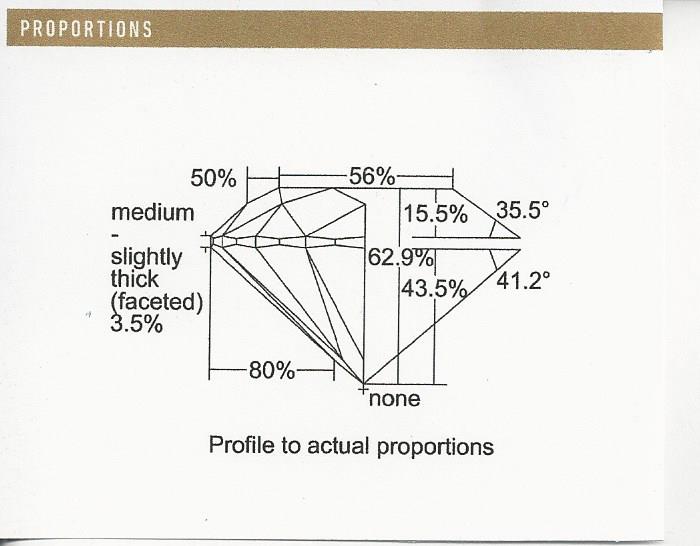
- This figure represents the table percentage which, like the
depth percentage, is one of the most important measurements
of the diamond. This is the relative size of the table (the
large flat area across the top of the diamond), expressed as
a percentage of the width of the stone. For example, if a diamond
with a 6.50 millimeter diameter (i.e., the Average Girdle Diameter)
has a table measuring 3.90 millimeters, the table percentage
is 60% (3.9 mm divided by 6.5 mm = 60%). Generally
speaking, the smaller the table %, the better the play of light
in the diamond.
There are two types of brilliance which come from a diamond:
life and fire. The "life" of the diamond is the white light
that is reflected from the table. The "fire" of the diamond
is the multicolored, scintillating light that comes from the
diamond. The fire comes from the "crown facets" that surround
the table and is regarded as being more beautiful than the "life" or white light.
Smaller
tables are desirable because, diamonds with small tables generally
have more fire and are more aesthetically pleasing than diamonds
with larger tables. However, diamond cutters frequently cut
large tables to save weight from the rough.
DIAGRAM A

53%-57.5%
- Ideal - If all the other factors on the G.I.A.
Report are acceptable (e.g. a crown angle of 33.5
to 35 degrees; a pavilion depth of 42.2%-43.8%; a pavilion angle of 40.4-41.2 degrees; Very Good
or Excellent polish and symmetry; and girdle and culet measurements
as defined, below) you will generally pay a premium of about 10% for stones with table percentages in this range, which produce
exceptional "fire".
57.6-60%
- Superior - If all the other measurements of the
diamond are within acceptable parameters, diamonds with tables
in this range demonstrate excellent brilliance and fire. Dimonz generally does not sell round diamonds with tables larger than 60%.
Diamonds with tables larger than 60% will have less fire than those with smaller tables.
- On a G.I.A.
Certificate, this figure represents the depth of the diamond
expressed as a percentage of it's width. To get the "depth percentage",
you take the depth of the stone in millimeters (the last figure
under measurements on a G.I.A. report) and divide by the diameter
(i.e., the Average Girdle Diameter). Generally
speaking, the Depth Percentage should be between 59% and
63.0%. Shallow stones with a depth percentage of
less than 58% are called "spready makes" in the gem trade. They
appear to be larger than normally cut stones of the same weight
because they are wider but they tend to be less brilliant because
the pavilion and crown angles are too shallow and light leakage results
(Diagram B, below,far right figure). Stones with a depth of over 64%
are termed "heavy" or "deep makes" (Diagram B, middle figure).
These stones will be less brilliant than well cut stones
and may appear to be dark because much of the light leaks out
of the bottom or pavilion of the stone because the pavilion
angle is too steep. Also called "Nailheads" (because they look
dark), these stones also appear to be smaller than normally
cut stones of the same weight because much of the weight is
in the depth of the stone.
DIAGRAM B
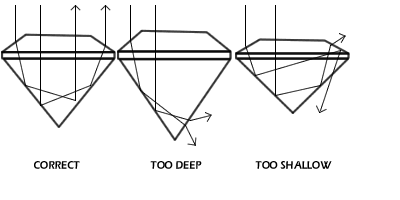
- This angle, which correlates directly to the pavilion depth,
is (IMHO)
the most important measurement in determining the brilliance
of a diamond. If the pavilion angle is too shallow or too steep, the diamond
is less brilliant because of light leakage (see Diagram B, above). I generally recommend a pavilion angle of 40.2 to 41.2 degrees.
- This the angle formed where the girdle intersects with the
crown (i.e., the top part of the diamond). This angle forms
a sort of prism that changes the white light reflected from
inside the diamond through the crown into the multicolored "fire." If the crown angle is too shallow or too deep, the fire of the
diamond is diminished. I generally recommend a crown angle of 34 to 35.5 degrees.
-- This factor measures
the thickness of the "girdle" or the outside circumference of
the diamond. There are typically two measurements given. The
first measurement reflects the minimum thickness and the second
reflects the maximum thickness for the girdle of the diamond.
If the girdle is the same thickness all the way round, there
will be only one measurement given. The measurements are as
follows: Extremely Thin, Very Thin, Thin, Medium, Slightly Thick,
Thick, Very thick, Extremely Thick.
DIAGRAM C
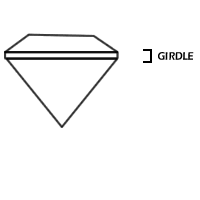
Do
not buy a diamond that has "extremely thin" as a girdle measurement
-- it may be prone to chipping along the girdle. Don't buy a
diamond that has "very thick" or "extremely thick" as a girdle
measurement-- the cutter has added unnecessary weight to the
diamond which you will pay for! Also don't buy or those have
a single measurement of "thick." Again, the cutter has added
unnecessary weight to the diamond.
Generally,
the following girdle thicknesses are acceptable: Thin; Thin
to Medium; Thin to Slightly Thick; Thin to Thick; Medium; Medium
to Slightly Thick; Slightly thick; Medium to Thick. Diamonds with Very Thin as one of the measurements may also
be acceptable.
The culet is a very small facet on the pointed end of the diamond (please see Diagram D, below). The following culet sizes are acceptable: none, very small, or small. Do not buy a diamond with a medium, large or very large culet. Medium to very large culets may be visible to the unaided eye through the top of the stone, appearing as a dark spot or small black hole in the center of the diamond.
DIAGRAM D
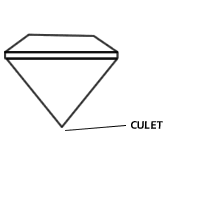
G.I.A. studies have shown that in addition to the pavilion angle, crown angle and table percentage, the length of the star facets and lower girdle facets can have a significant impact on the light return and aesthetics of the stone. The triangular star facets on the crown should have a length of 50%-55% (i.e., at least half the distance between the table and the girdle) and the pairs of lower girdle facets should extend from 75%-80% of the distance between the girdle and the culet (please see the Proportions diagram, above).

